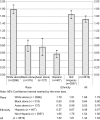Racial and ethnic differences among amyotrophic lateral sclerosis cases in the United States
- PMID: 25482100
- PMCID: PMC4389704
- DOI: 10.3109/21678421.2014.971813
Racial and ethnic differences among amyotrophic lateral sclerosis cases in the United States
Abstract
Our objective was to describe racial and ethnic differences of amyotrophic lateral sclerosis (ALS) in distinct geographic locations around the United States (U.S.). ALS cases for the period 2009-2011 were identified using active case surveillance in three states and eight metropolitan areas. Of the 5883 unique ALS cases identified, 74.8% were white, 9.3% were African-American/black, 3.6% were Asian, 12.0% were an unknown race, and 0.3% were marked as some other race. For ethnicity, 77.5% were defined as non-Hispanic, 10.8% Hispanic, and 11.7% were of unknown ethnicity. The overall crude average annual incidence rate was 1.52 per 100,000 person-years and the rate differed by race and ethnicity. The overall age-adjusted average annual incidence rate was 1.44 per 100,000 person-years and the age-adjusted average incidence rates also differed by race and ethnicity. Racial differences were also found in payer type, time from symptom onset to diagnosis, reported El Escorial criteria, and age at diagnosis. In conclusion, calculated incidence rates demonstrate that ALS occurs less frequently in African-American/blacks and Asians compared to whites, and less frequently in Hispanics compared to non-Hispanics in the U.S. A more precise understanding of racial and ethnic variations in ALS may help to reveal candidates for further studies of disease etiology and disease progression.
Keywords: Amyotrophic lateral sclerosis; epidemiology; incidence studies; motor neuron disease; race.
Figures
References
-
- Chio A, Mora G, Calvo A, Mazzini L, Bottachi E, Mutani R. Epidemiology of ALS in Italy: a 10-year prospective population based study. Neurology. 2009;72:725–31. - PubMed
-
- McGuire V, Longsreth WT, Koepsell TD, van Belle G. Incidence of amyotrophic lateral sclerosis in three counties in western Washington State. Neurology. 1996;47:571–3. - PubMed
-
- Sorenson EJ, Stalker AP, Kurland LT, Windebank AJ. Amyotrophic lateral sclerosis in Olmsted County, Minnesota, 1925–1998. Neurology. 2002;59:280–2. - PubMed
Publication types
MeSH terms
LinkOut - more resources
Full Text Sources
Other Literature Sources
Medical
Miscellaneous

